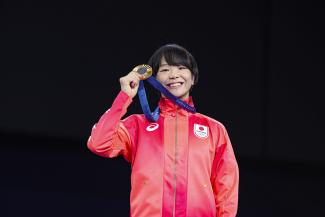Mexico Hosts Level 1 Coaches Course
Sunday, March 20, 2022 - 19:23 By United World Wrestling Press

MEXICO CITY, Mexico (March 23) – UWW's Education Program and the Mexican Olympic Sports Center (CDOM) welcomed 40 participants from all over Mexico for a Level I Coaches Course from March 5-9. The course was made possible through the support of the Mexican Olympic Committee, Olympic Solidarity, and the Mexican Wrestling National Federation.
The purpose of the four-day course was to provide coaches with tools to strengthen their professional work. The course consisted of several theoretical and practical sessions that were structured to be transferrable from the classroom to the mat.
The opening ceremony was held at the Presidency Auditorium of the Mexican Olympic Committee and was attended by distinguished personalities such as Maria José ALCALÁ IZGUERRA, President of the NOC, Guillermo DÍAZ GUTIÉRREZ, President of the Mexican Wrestling Federation and Daniel ACEVES VILLAGRÁN, Vice-President of NOC. The Olympic Wrestling Gymnasium was inaugurated as part of the event, a space designed to house the national teams and the Olympic Wrestling initiation school.
In April, wrestlers from all over the continent will train at these new facilities for the Pre-Pan-American Championship Training Camp.

The Olympic Wrestling Gymnasium in Mexico City, Mexico. (Photo: United World Wrestling)
This course was conducted by two renowned Cuban coaches Filiberto DELGADO (FS & WW) and Raul TRUJILLO DIAZ (GR), in collaboration with UWW Educator Arturo CAMACHO IBARRA (MEX).
"The course was very important; I was flattered with the youth, the desire, and unity that exists today among wrestling; I saw a great preparation in most young people, very into what they want to achieve, who should not conform and have bigger goals," said Filiberto DELGADO.
Also, during the course, an Anti-doping workshop was given by Dr. Viridiana SILVA, Mexican Olympic Committee Medical Director.
All the participants agreed that they would like to have part two of this course. "Thank you very much for doing these types of courses because they are necessary and valuable. It is important to continue to carry them out constantly to improve the knowledge and level of the wrestling, " said Gloria Wendoline MORENO SOTELO.

Over 40 participants from all over Mexico attended the Level I Coaches Course from March 5-9. (Photo: United World Wrestling)
Yuri MAIER, United World Wrestling Sports & Development Officer, was very pleased with the outcome of the course. "In general terms, everything went very well. The Mexican National Federation is undoubtedly one of the most proactive NFs in the continent. We hope to continue working with them in this way and accompanying them in their growth and institutional strengthening."


Share your thoughts.
Comments